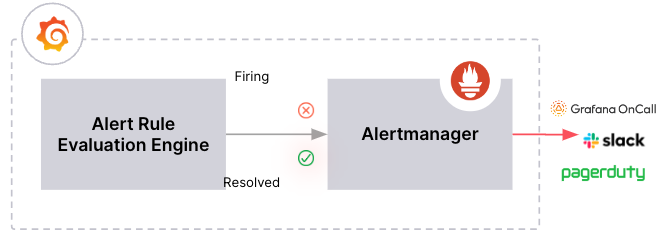Important: This documentation is about an older version. It's relevant only to the release noted, many of the features and functions have been updated or replaced. Please view the current version.
Configure Alertmanagers
Grafana Alerting is based on the architecture of the Prometheus alerting system. Grafana sends firing and resolved alerts to an Alertmanager, which is responsible for handling notifications.

Grafana has its own pre-configured Alertmanager, referred to as “Grafana” in the user interface:
Grafana Alertmanager is the default internal Alertmanager if you run Grafana on-premises or as open source. It can receive alerts from Grafana but cannot receive alerts from external alert generators such as Mimir or Loki.
Cloud Alertmanager runs in Grafana Cloud and can receive Grafana-managed alerts and Data sources-managed alerts like Mimir, Loki, and Prometheus.
Grafana Alerting also supports sending alerts to External Alertmanagers, such as the Prometheus Alertmanager, which can receive alerts from Grafana, Loki, Mimir, and Prometheus.
You can use both internal and external Alertmanagers. The decision often depends on your alerting setup and where your alerts are being generated. Here are two examples of when you may want to add an external Alertmanager and send your alerts there instead of the default Grafana Alertmanager:
You may already have Alertmanagers on-premises in your own Cloud infrastructure that you still want to use because you have other alert generators, such as Prometheus.
You want to use both Prometheus on-premises and hosted Grafana to send alerts to the same Alertmanager that runs in your Cloud infrastructure.
Add an external Alertmanager
From Grafana, you can configure and administer your own external Alertmanager to receive Grafana alerts.
Note
Grafana Alerting does not support sending alerts to the AWS Managed Service for Prometheus due to the lack of sigv4 support in Prometheus.
After you have added the Alertmanager, you can use the Grafana Alerting UI to manage silences, contact points, and notification policies. A drop-down option in these pages allows you to switch between alertmanagers.

External alertmanagers should now be configured as data sources using Grafana Configuration from the main Grafana navigation menu. This enables you to manage the contact points and notification policies of external alertmanagers from within Grafana and also encrypts HTTP basic authentication credentials.
To add an external Alertmanager, complete the following steps.
Click Connections in the left-side menu.
On the Connections page, search for
Alertmanager.Click the Create a new data source button.
If you don’t see this button, you may need to install the plugin, relaunch your Cloud instance, and then repeat steps 1 and 2.
Fill out the fields on the page, as required.
If you are provisioning your data source, set the flag
handleGrafanaManagedAlertsin thejsonDatafield totrueto send Grafana-managed alerts to this Alertmanager.Note: Prometheus, Grafana Mimir, and Cortex implementations of Alertmanager are supported. For Prometheus, contact points and notification policies are read-only in the Grafana Alerting UI.
Click Save & test.
Note
On the Settings page, you can manage your Alertmanager configurations and configure where Grafana-managed alert instances are forwarded.
- Manage which Alertmanagers receive alert instances from Grafana-managed rules without navigating and editing data sources.
- Manage version snapshots for the built-in Alertmanager, which allows administrators to roll back unintentional changes or mistakes in the Alertmanager configuration.
- Compare the historical snapshot with the latest configuration to see which changes were made.



